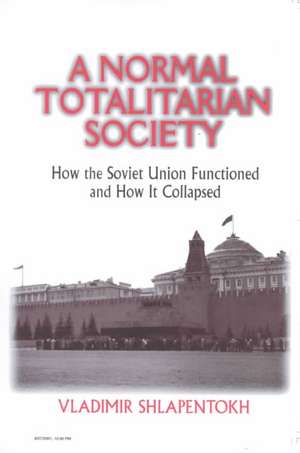A Normal Totalitarian Society: How the Soviet Union Functioned and How It Collapsed
Autor Vladimir Shlapentokhen Limba Engleză Paperback – 31 ian 1997
Preț: 413.33 lei
Nou
Puncte Express: 620
Preț estimativ în valută:
79.12€ • 85.97$ • 66.50£
79.12€ • 85.97$ • 66.50£
Carte tipărită la comandă
Livrare economică 21 aprilie-05 mai
Preluare comenzi: 021 569.72.76
Specificații
ISBN-13: 9781563244728
ISBN-10: 1563244721
Pagini: 288
Dimensiuni: 152 x 229 x 23 mm
Greutate: 0.39 kg
Ediția:1
Editura: Taylor & Francis
Colecția Routledge
Locul publicării:Oxford, United Kingdom
ISBN-10: 1563244721
Pagini: 288
Dimensiuni: 152 x 229 x 23 mm
Greutate: 0.39 kg
Ediția:1
Editura: Taylor & Francis
Colecția Routledge
Locul publicării:Oxford, United Kingdom
Cuprins
1: Theoretical Concepts; 2: Two Components of Soviet Ideology; 3: Adjusting the Revolutionary Ideology to Totalitarian Goals; 4: World Revolution As a Geopolitical Instrument; 5: Open and Closed Ideologies; 6: Policy Toward Key Social Groups Workers and Creative Intelligentsia; 7: The Political System The Supreme Leader As the Major Institution; 8: An Effective Political Machine; 9: The Economy Organic Flaws and Achievements; 10: Public Opinion Acceptance of the Regime; 11: The Regime and the Empire A Complex Relationship; 12: Reforms Alternatives in History; 13: Reforming the System, Destroying Its Fundamentals; 14: Consequences; Conclusion
Descriere
This study analyzes the ordinary functioning of the Soviet system from Stalin's death through the Soviet collapse and Russia's first post-Soviet decade. Without overlooking the USSR's repressive character, the author treats it as a "normal" system that employed socialist and nationalist ideologies.





